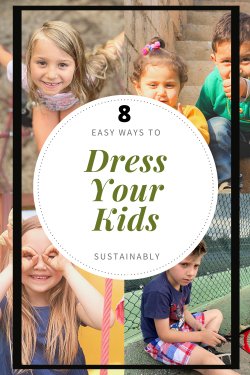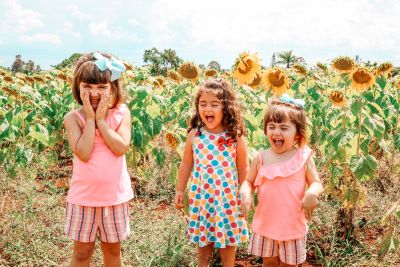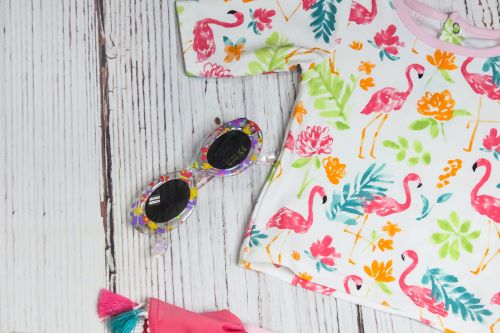There was a time when I barely thought about how wasteful it was to cycle through children’s clothing size after size. Children are very hard on their clothing and require way more clothing in the span of 10 years than most adults do in a lifetime. As my life became more and more conscious of the footprint that we leave on the earth, I had to take a good look at how I purchase, use, and dispose of the clothing for my children.
The fast fashion industry has been deemed as the second-worst polluting industry on earth. The waste and pollution it produces in the manufacturing of garments and the textile waste after use are no small potatoes! The clothing and textile industry is is responsible for up to 8% of the world’s greenhouse gas emissions.
Here I share with you some of the easiest tips I learned in trying to dress my children more sustainably.

1. Regifting is ok!
Children get so many gifts around the holidays, regifting what you won’t need is sustainable living.
We’ve all done it! You get a clothing gift for your child and even though you don’t LOVE it, you rip off the tags, put it on the baby once, and stuff it in the drawer never to be seen again! Marie Kondo says in the Life-Changing Magic of Tidying Up that “The true purpose of a present is to be received”. Once you have received it, thank it for what it represents and the joy it gave you at the moment of receiving it and put it in the re-gift pile.
Sustainable clothing is also clothing that is used often, loved, and lasts. If you don’t see yourself using it much because of its inferior quality, synthetic materials, or personal style, it is much better off with someone else. This tip relates most to children since they are often gifted items of clothing for birthdays and holidays. You will also save money on gifts, and be happier knowing that your child will be wearing natural, toxin-free clothing.
2. Shop second hand
Shopping second-hand is so mainstream now that stores are popping up everywhere! You can find stores in your local neighbourhood, and many second hand kids clothes online. The fast fashion industry carries with it a lot of pollution, waste, and exploitation. Shopping second-hand for your child’s clothes limits these negative aspects. Not to mention the amount of packaging, new materials, and transport costs associated with new clothing.
Clothing today is being manufactured with continuously lower standards: quicker stitching, lower-quality materials, and mixed synthetic fabrics. They are made to look great in the store and fall apart after only a few washes. With second-hand clothing, you can at least be assured that it has already stood the wash test, having been already washed and dried several times over.

3. Look into sustainable brands
I know how tempting it can be to cruise through H&M kids to see all of the cute outfits and low prices. The problems with this type of fast fashion lie in what’s under the label: poor labour standards, inferior products and environmental problems.
Sustainable brands for kids work above the standards dictated by fast fashion. Sustainable brands use natural fabrics and dyes; quality thread and stitching and pay their workers a fair wage. Brands such as Aster and Oak, Organic Nights, Nature Baby and Monica and Andy prioritise the health of their clients, the environment and the quality of their products so that they last longer. Even better, Australian made baby clothing brands are ethically made and supports local business.
4. Choose materials that are natural and sustainable
Kids’ clothing is something we rarely think of as a health hazard, but unsustainable materials can come at a cost to the health of the planet. Thousands of chemicals are used in the production of mainstream fashion. The dyes used and the finishing materials to keep clothing looking wrinkle-free and pristine for purchase are among some of the chemicals present.
Sustainable clothing companies for kids use fabrics such as organic cotton, hemp, Tencel, and bamboo to make less of an environmental footprint. They use less water in production and stick to natural dyes. If you are interested in learning more about how sustainable fashion is saving the world read 10 Ways Slow & Sustainable Fashion is Saving the World.
5. Watch out for fabrics which shed microplastics
Billions of particles of microplastics from textiles are flushed into our oceans each year.
If you’re concerned about the environmental impact when clothing your children, make sure to steer clear of the worst offenders. Materials made from fossil fuels such as fleece, spandex and Lycra do damage where we can’t even see it. The fashion industry is the second largest contributor to pollution and that includes the millions of tons of microplastics being flushed into our oceans every year!
If you do happen to own these fabrics for your children, make sure to wash them on cold, and skip the dryer to limit the amount of microplastics that cannot be filtered by your municipal water systems. If you’re interested in learning more about microplastics, read 11 Rules for Addressing the Modern Microplastic Mess.
6. Ask for experience gifts

Embracing a more minimalist mentality works hand-in-hand with dressing your children sustainably. Ask friends and family members to give experience gifts or consumable gifts rather than clothing for your child. Gifts such as a museum membership, passes to a play-park or swimming lessons, allow you to choose how you shop for your child’s clothing rather than have them gifted.
Family and friends always mean well with their gifts, but are often not on the same sustainable journey as you are. They will most likely pick up fast fashion outfits with unsustainable materials. Be proactive and limit fast-fashion purchases.
7. Repurpose and reinvent
This is one that I do all of the time! When pants have a hole in the knee, I either patch it or cut off the legs and sew a hem to make shorts. The cutoff part becomes a rag, and the shorts end up being a favourite in the closet. Dresses that are too small become tunics and long-sleeves that are too short become short-sleeve shirts.
You will need to have some basic sewing skills for this one, but the possibilities are endless with a little knowledge of sewing.
It’s even better if you can mend and repair worn clothes. Knowing a reliable tailor is really valuable and don’t forget about repairing shoes too.
Turning your child’s old clothes into a sewing project is always a possibility too! Making quilts with baby clothing is fun, and keeps the memories of the clothing alive for much longer. Take a look at the quilt I am making with my daughter’s baby clothes.

8. Hang to dry or use dryer balls
The dryer is the most energy-sucking appliance in your home. According to the Guardian, drying your clothing on a clothesline instead of the dryer could reduce your carbon footprint by 453kg of carbon per year! If we all chose to do that, we could greatly reduce our carbon. Bill Gates discloses in his book “How to Avoid a Climate Disaster” that we need to reduce 50 billion tons of carbon by 2050. Every little bit gets us closer to this goal.
If you’re in an apartment or drying your clothing on a line is simply not possible, use dryer balls to reduce your drying time. Dryer balls will also help avoid single-use plastic and chemicals that are used in dryer sheets.
What Next?
Whether you’re just starting out on your journey to making your life more green, or you’ve been at this for years, taking a better look at how you treat your children’s wardrobe is part of an effective strategy. Clothing is a necessary part of our lives, and adapting a few better habits could help you and your family save money and can help the world be a better place. Imagine the environmental impact that millions of people adopting these strategies could have on the world!
About the Author

Eva Petruzziello is the Editor-in-Chief of Simple n’ Delight, a website about sustainable living. She is the mother of two children, and an elementary teacher in Toronto, Canada. She is a leader for Eco-Schools and teaches children how to live a more sustainable and environmentally sound life. In her own household, she embraces steps towards a zero-waste lifestyle by composting, recycling, and adopting sustainable strategies to save money and keep our planet green. Follow Eva on Pinterest, Facebook and Twitter.
Read more articles on raising green kids:
- 10 Picture books on sustainability perfect for preschoolers
- Top tips for gardening with kids (and how to get them excited about it)
- How to have an eco friendly baby
- Best reusable swim nappies
- 10 Best Baby and Kids Second Hand Clothing Stores Online
Image credits:


Thrifting is definitely one of the best tips and one of the best things in my life I love a good thrift shop whether it be online or in person, great post!
Asking for “experience gifts” is so key especially as your kids are older and they have plenty of clothes and toys!
I loved this post! It really made me think about how many brand new outfits I buy for my son that he’ll only wear a handful of times. Maybe I should start thrifting!
Love shopping second-hand. And once my kids outgrow we always donate or give away to friends.
Great post! Asking for experience gifts is an awesome idea. Regifting is also something I’ve been considering lately.
These are some great ideas, shopping second hand is a great idea and one that I do a lot, and I love the idea of asking for experience gifts
These are wonderful ideas! I love the repurposing suggestion. I’ve been holding on to some of my sons baby clothes to make into a keepsake quilt. I also love the idea of gifting experiences. So cool!